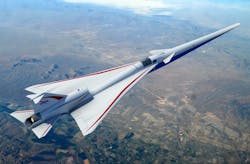The X-59: A Problematic Project
NASA’s latest X plane, the X-59 QueSST, is part of that organization’s long heritage of developing and exploring capabilities that could be used by commercial and private aircraft. The agency’s never really been dedicated just to space exploration and military spin-offs.
The goal for this X plane is to see if technologies and features dreamt up by engineers at NASA and elsewhere can really muffle a sonic boom, or at least dial down its volume and effects to acceptable levels. It was the lack of this capability and the intrusive nature of sonic booms that doomed the first supersonic airliner, the Concorde. The jet was forbidden to travel supersonic over land, severely limiting the number of routes on which it could show off its high speed.
To ensure the NASA-modified boom is acceptable to folks on the ground, the X-59 will fly over several U.S. cities, buzzing them at Mach 1.4 and 55,000 ft—much faster and higher than conventional airliners. NASA will then poll the public to see what they thought of the revised booms.
This could be a problem. The American people can be a fussy lot; I would wager that 20% of the population will not want planes zipping by overhead at supersonic speeds, even if they only made a whisper. Some will complain about the (non-existent) noise, others will worry about a supersonic missile crashing into their neighborhood. And if the noise is truly harsh, bouncing pictures off the walls, cracking plaster and mirrors, and smashing picture windows, it’s a done deal for supersonic airliners. For NASA’s sake, I hope they have the science and engineering right.
A bleaker scenario is that the boom is moderately loud…loud enough for NASA to justify nixing supersonic airliners. But then all the aircraft companies and airlines that believe supersonic travel is the key to filling their coffers might start applying pressure on NASA and politicians they lobby (behind closed doors, of course). NASA might then massage the numbers and approve supersonic flight over land. If it went down like that and NASA capitulated—even though the booms were scaring chickens out of laying eggs and cows out of giving milk, in addition to routinely waking sleeping infants—it would cripple one of the few trustworthy institutions left in the U.S.

